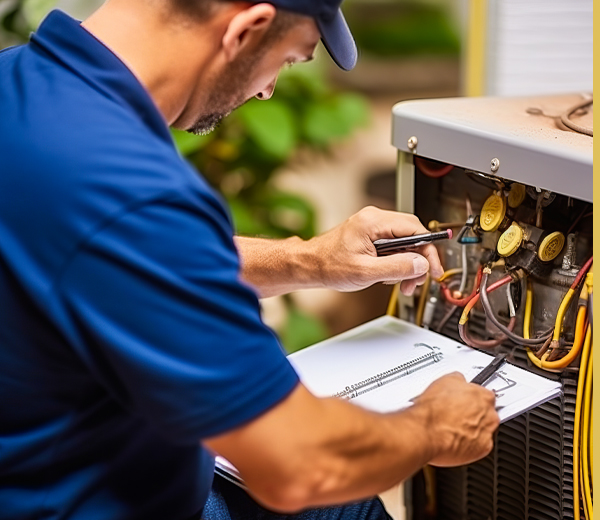PROGRAM
Air Conditioning, Refrigeration and Heating Technology

Associate in Science
Air Conditioning, Refrigeration and Heating Technology
Program Overview
The Air Conditioning, Refrigeration, and Heating Technology Associate Degree Program at CBT Technology Institute provides a comprehensive education with a blend of lectures and lab work. This balanced approach ensures you gain both theoretical knowledge and practical experience in a simulated work environment in our well-equipped labs
After completing this program and earning your degree, you will be prepared for mid-level roles in the in-demand HVAC-R industry, mastering the installation, design, maintenance, and repair of residential and commercial systems. This program is offered in both English and Spanish and will prepare you for the Journeyman Certification upon acquiring the necessary experience. Let us help you prepare for your future career. Speak with an air conditioning advisor before registering to get started
Program Details
- Total Semester Credits: 60
- Program Length: 20 months
- Next Start Date: July 08, 2024
- Location: Offered at Hialeah and Flagler Campuses
- Language of Instruction: English and Spanish
- Delivery Mode: Traditional On-Ground and via Hybrid distance education modality
- ESCO Certifications: Basic Refrigeration and Charging Procedures, Brazing and Soldering, Low GWP Refrigerant Safety, OSHA -10, NCCER CORE, and NCCER Level 1 Air Conditioning, EPA 608, EPA 609
Note: Completing a course or program in a language other than English may reduce employability where English is required.
COURSE DESCRIPTIONS
EET1033 – Fundamentals of Electricity (3 Semester Credits Hours)
This course offers a general introduction to the principles, concepts and laws applied to electric circuits. In-depth coverage of Ohm’s Law and its relation to voltage, current, resistance, followed by theoretical and practical applications of electrical components connected in series, parallel and series-parallel circuits. Also, the course focus on understanding of AC theory, components such as inductors, capacitors, transformers, electronics and semiconductors components, and its applications as well as the principles of operation of different devices and its appropriate selection.
CET1516 – Electric Motors Application (3 Semester Credits Hours)
This course is focused on the characteristics, operation, control, selection, installation and applications of different electric motors. Electric motors such as: single phase, three phases, hermetic compressors, multi-speed and variable and electronically commutated are studied. Activities in the labs are planned in order to connect, wiring starting methods, interpret connection diagrams and verify technical conditions of parts and troubleshooting. In addition, electrical and safety codes also will be emphasized.
ACR1052 – Fundamentals of Refrigeration and Air Conditioning (3 Semester Credit Hours)
This course is an introduction to basic concepts related to heat and air conditioning cooling, the study of the physical laws relating to refrigerants and basic components of a mechanical refrigeration system for vapor compression. It Includes topics such as: Types and functions of compressors, condensers, evaporators and expansion, types of refrigerants, the ozone layer, the rules of the Environmental Protection Agency, how to solder copper pipes, description of how a vacuum is done, how to charge a refrigeration system with refrigerant and the use of the recovery machine. The course will be focused on saving energy and preserving the environment by using green technologies with special attention to new technologies applied to high efficiency HVAC systems, as well as studying the mechanical and safety codes on the most significant topics related to the subject. This course is also taught in the Spanish Language.
ACR1113 – Refrigeration and Air Conditioning Electrical Systems (3 Semester Credit Hours)
A study of electrical circuits applied to air conditioning and heating. Topics include electrical symbols, schematics, real circuits, diagnostics of the most common electrical problems in a compressor’s electric motor, and forms or methods used to start a compressor. Other topics include electrical connections and air conditioning system protective controls, as well as explaining and making electrical connections of low voltage components. The course content will be taught through theory and practice. The course will be focused at saving energy and preserving the environment by using green technologies with special attention to new technologies applied to high efficiency HVAC systems, as well as studying the electrical and safety codes on the most significant topics related to the subject. This course is also taught in the Spanish Language.
ACR1215 – Commercial Refrigeration Systems. Service and Troubleshooting (3 Semester Credit Hours)
This course covers the installation and operation of different types of air conditioning systems. Topics include: mechanical components, standard and higher efficiency of the refrigeration cycle and indicators for the heat and cooling loads calculation, types of air conditioning systems: conditioner wall/window and mini-split system, split systems, package units and heat pumps. New technologies and advances in air conditioning systems designed high-efficiency are addressed. Skills develop in services, installation and repair of different air conditioning systems. In addition mechanical and safety codes will be emphasized.
ACR1500 – Air Conditioning Systems, Service and Troubleshooting (3 Semester Credit Hours)
This course discusses the installation and operation of different types of air conditioning systems used today. Topics include basic concepts of air conditioning systems, comfort conditions, AC load estimation, the use of diagrams, mechanical components of the system, and types of equipment including basics of heating systems. In workshops, students will acquire skills in handling tools and measurement instruments in the repair and installation of the units and components. The course will be focused at saving energy and preserving the environment by using green technologies with special attention to new technologies applied to high efficiency HVAC systems, as well as studying the mechanical and safety codes on the most significant topics related to the subject. This course is also taught in the Spanish Language.
ACR2420 – Air Distributions Systems and Duct Work (3 Semester Credit Hours)
This course is an introduction to the basic principles of air distribution and ventilation in AC systems. Topics include indoor air quality, methods for controlling pollution sources, ventilation and the use of means for cleaning the air, concepts of MERV and Naima, psychometrics, humidification, humidifiers, sizing, installation and servicing, troubleshooting and preventive maintenance, and ASHRAE 62.1 2007, and standards of acceptable indoor air quality. Other topics include duct system design, fundamentals of air flow, analysis of balance or equilibrium in supply and return ducts, DOAS systems, duct works, and insulation measurements. The course will be focused at saving energy and preserving the environment by using green technologies with special attention to new technologies applied to high efficiency HVAC systems, as well as studying the mechanical and safety codes on the most significant topics related to the subject. This course is also taught in the Spanish Language.
ACR2031 – Blueprints and Design Code (3 Semester Credits Hours)
Blueprint Reading is an entry level course, primarily delivered through lectures and practical exercises. The study of the principals involved in the use and interpretation of the drawings and specifications commonly used in construction. Plan views, elevations, sections and schedules are examined in depth. Use of various lines and symbols are explained. Students will practice visualizing the three-dimensional building from two dimensional drawings in a heating, ventilating, and air-conditioning (HVAC/R) field. Topics include concepts of geometric figures and formulas, conversion tables, common abbreviations, symbols, drawing, sketching, views, plans, schedules, and technical specifications. The students also work with the Florida Building Mechanical Code to obtain a better understanding of the principles, regulations and organization of the different topics included in the course. This course is also taught in the Spanish Language.
ACR2310 – Advanced Automatic Controls (3 Semester Credit Hours)
This course covers different types of automatic controls used in air conditioning and refrigeration systems. Topics include: fundamentals of HVAC/R control systems, control loops, methods and modes, sensors and auxiliary devices, control logic and variable frequency drive (VFD) in electrical motor HVAC/R equipment, control valves and dampers, self- and system-powered controls, pneumatic, electric and electronic controls, programmable logic controllers (PLC), direct digital control (DDC), digital and analog interfaces and control diagrams and sequences. New technologies and advances in control systems designed are addressed. Skills develop in services and troubleshooting in different control systems HVAC/R. In addition mechanical, electrical and safety codes will be emphasized.
ACR2611 – Heating Systems (3 Semester Credit Hours)
This course discusses the different heating systems for heating the air. Topics include: basic concepts and mechanical components, types of heating systems: heat pump systems, electric heating, and gas heating systems, heating systems and heating oil hydrodynamics. The course will be focused at saving energy and preserving the environment by using green technologies with special attention to new technologies applied to high efficiency HVAC systems, as well as studying the mechanical and safety codes on the most significant topics related to the subject. This course is also taught in the Spanish Language.
ACR2167 – Air Conditioning Calculations (3 Semester Credit Hours)
This course provides the procedures for calculating heat load for air conditioning in residential, commercial and industrial buildings and heat load for commercial refrigeration systems. Topics include: the exterior and interior design conditions, evaluation of external heat loads, gains and solar radiation structures, evaluation of internal charges: occupants, lights, motors, equipment, technological processes, the evaluation of load infiltration and ventilation, breathing products. Other course elements include the psychrometric chart, the representation of air treatment processes and the selection of air conditioning and refrigeration equipment. Special attention to new technologies and building materials as well as new insulation systems used in air conditioning and refrigeration equipment and high efficiency equipment are covered. Students also study the mechanical and safety codes most relevant to the subject. This course is also taught in the Spanish Language.
ACR2770 – Chilled-Water Air Conditioning Systems (3 Semester Credit Hours)
This course discusses the different types of chillers: high pressure, low pressure and absorption that are currently used in air conditioning systems. In addition, it also discusses the types of cooling towers. Topics include: basic mechanical components of the system: compressor, direct expansion evaporator and flooded, air-cooled condensers and water, expansion devices of systems of high and low pressure, the equipment components of absorption systems, startup, commissioning and maintenance of all types of water chillers. The course will be focused on saving energy and preserving the environment by using green technologies with special attention to new technologies applied to high efficiency HVAC systems, as well as studying the mechanical and safety codes related to the subject. This course is also taught in the Spanish Language.
BCN1872 – Energy Efficiency in Buildings and Construction Codes (3 Semester Credit Hours)
This course presents standards of product temperatures for preservation and health. Topics addressed include retrofitting, recovery, evacuation, start-up, charging, troubleshooting of commercial refrigeration systems. Supermarket refrigeration, parallel rack systems, multi- compressor lubrication, secondary refrigerant systems, walk-in refrigerators and freezers, refrigeration load calculation, proper piping practices. Ice machine, types and applications, installation, service and troubleshooting. Transport refrigeration, rapid freezing and cascade systems. New refrigerants used in commercial refrigeration systems.
ETC1207 – HVAC/R Projects Estimating (3 Semester Credit Hours)
This course describes concepts, principles, and techniques used to estimate projects. It covers topics like the estimating process, types of estimates, the quantity takeoff, directs and indirect cost, bidding strategies, examples of estimating projects. A project of estimating will be complete and evaluated at the end of the course.
ACR2760 – Alternative Energy Applied to HVAC (3 Semester Credit Hours)
This course will describe the different alternative energy systems. The course covers topics like fossil energy, nuclear energy, solar energy, wind energy, ocean energy, and geothermal energy. The course illustrates how HVAC systems use alternative energy and also covers the efficiency of the compression cycle and absorption refrigeration cycle combined with different energy generation systems.
ENC1100 – English Composition I (General Education Component) (3 Semester Credit Hours)
This course is the first college level English course for students. This course emphasizes the skills necessary to prepare you for college level writing. In this course students will develop an understanding of effective, college level writing with an emphasis on exposition and research essays. Oral and written communications of impressions and judgments concerning assigned readings in the essay and allied genre are required. This course also focuses on the building of an active vocabulary and on correct sentence and paragraph structure.
SPC1013 – Speech (General Education Component) (3 Semester Credit Hours)
The course includes theories and practices in oral communication and speech writing, and the process of oral communication in all types of organizations. Students will learn the fundamentals of effective oral communication, with an emphasis on delivering effective presentations. This course will cover skills and techniques for planning and delivering a presentation, overcoming anxiety, and working with various audiences. Students will also use Microsoft PowerPoint to create and present an automated slide show presentation. This course is also taught in the Spanish Language.
MAC1100 – Principles of College Algebra (General Education Component) (3 Semester Credit Hours)
The students will be introduced to the concepts necessary for the algebraic operations and will be instructed in the understanding of the real number system, polynomials, graphing of linear equations, equalities, and inequalities. The subject will be an application-driven course using real data to solve real world problems. This course is also taught in Spanish.
AMH2022 – US History (General Education Component) (3 Semester Credit Hours)
This course will examine significant events, movements, and patterns that have helped shape the modern world. While our emphasis will be on the 19th and 20th centuries, we will delve deeper into history to connect modern forms of democracy, culture, and conflict to their historical roots.
PHY1022 – Fundamentals of Physics (3 Semester Credit Hours)
This is an introductory course focused on electromagnetics topics and thermodynamics. It covers a study of electric charges, forces, and field, Coulomb's law, electric potential, and electric potential energy, and an introduction to magnetism. The course also includes thermal physics, transfer of energy in thermal processes, and the laws of thermodynamics.




